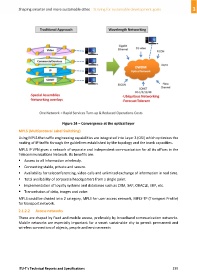Page 249 - Shaping smarter and more sustainable cities - Striving for sustainable development goals
P. 249
Figure 24 – Convergence at the optical layer
MPLS (Multiprotocol Label Switching)
Using MPLS the traffic engineering capabilities are integrated into Layer 3 (OSI) which optimizes the
routing of IP traffic through the guidelines established by the topology and the trunk capacities.
MPLS IP VPN gives a network of separate and independent communication for all its offices in the
Telecommunications Network. Its benefits are:
Access to all information wirelessly.
Connecting stable, private and secure.
Availability for teleconferencing, video‐calls and unlimited exchange of information in real time.
Total availability of corporate headquarters from a single point.
Implementation of loyalty systems and databases such as CRM, SAP, ORACLE, ERP, etc.
Transmission of data, images and voice.
MPLS could be divided into 2 category, MPLS for user access network, MPLS‐TP (Transport Profile)
for transport network.
2.1.2.2 Access networks
These are shaped by fixed and mobile access, preferably by broadband communication networks.
Mobile networks are especially important for a smart sustainable city to permit permanent and
wireless connection of objects, people and environments
ITU‐T's Technical Reports and Specifications 239

